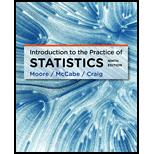
Concept explainers
To find: The joint distribution, two marginal distributions and conditional distribution.
Answer to Problem 25E
Solution: The joint distribution of times by sex is shown below:
Joint Distribution |
|
More and boys |
37.23% |
More and girls |
34.13% |
Never and boys |
5.39% |
Never and girls |
7.12% |
Once and boys |
6.36% |
Once and girls |
9.77% |
The marginal distribution of ‘gender’ is shown below:
Gender |
||
Boys |
Girls |
|
Marginal distribution |
||
The marginal distribution of ‘times’:
Times |
Marginal distribution |
More |
|
Never |
|
Once |
The conditional distribution of ‘sex’ by time is shown below:
Gender |
|||
Times |
Boys |
Girls |
Total |
More |
52.17% |
47.83% |
100% |
Never |
43.09% |
56.91% |
100% |
Once |
39.43% |
60.57 |
100% |
The conditional distribution of ‘time’ by sex is shown below:
Times |
Boys |
Girls |
More |
76.01% |
66.90% |
Never |
11.01% |
13.96% |
Once |
12.98% |
19.14% |
Total |
100% |
100% |
Explanation of Solution
Calculation: Joint distributions are computed by dividing the cell element by the total observation. Hence, the table which shows the joint distribution is given below:
Gender |
|||
Times |
Boys |
Girls |
Total |
More |
37.23% |
34.13% |
71.36% |
Never |
5.39% |
7.12% |
12.51% |
Once |
6.36% |
9.77% |
16.12% |
Total |
48.98% |
51.02% |
100% |
The joint distribution of Boys who had more sexually harassed can be calculated as:
The joint distribution of Boys who had never sexually harassed times can be calculated as:
Thus, the remaining joint distribution can be calculated by using the above formula.
Marginal distributions are computed by dividing the row or column totals by the overall total. Marginal distribution provides information about the individual variables but it does not provide any information about the relationship between two variables. Marginal distribution of Gender:
Gender |
||
Boys |
Girls |
|
Marginal distribution |
||
Marginal distribution of Times:
Times |
Marginal distribution |
More |
|
Never |
|
Once |
Conditional distributions of one variable restricted to a single outcome of another variable. Conditional distributions are computed by the row or column elements by the total of that row or column observation. Conditional distribution of gender who had sexually harassment is shown below:
Gender |
|||
Times |
Boys |
Girls |
Total |
More |
52.17% |
47.83% |
100% |
Never |
43.09% |
56.91% |
100% |
Once |
39.43% |
60.57 |
100% |
The conditional distribution of Boys who had more sexually harassed can be calculated as:
Thus, the remaining conditional distribution of gender by the category time can be calculated by using the above formula.
Now, the conditional distribution of time for each gender category is shown below:
Times |
Boys |
Girls |
More |
76.01% |
66.90% |
Never |
11.01% |
13.96% |
Once |
12.98% |
19.14% |
Total |
100% |
100% |
The conditional distribution of time for each gender can be calculated as:
Thus, the remaining conditional distribution of time for each gender can be calculated by using the above formula.
To explain: Conditional distribution to explain the result of analysis.
Answer to Problem 25E
Solution: The distribution of times by sex is preferable for the analysis.
Explanation of Solution
Want to see more full solutions like this?
Chapter 9 Solutions
Introduction to the Practice of Statistics
 MATLAB: An Introduction with ApplicationsStatisticsISBN:9781119256830Author:Amos GilatPublisher:John Wiley & Sons Inc
MATLAB: An Introduction with ApplicationsStatisticsISBN:9781119256830Author:Amos GilatPublisher:John Wiley & Sons Inc Probability and Statistics for Engineering and th...StatisticsISBN:9781305251809Author:Jay L. DevorePublisher:Cengage Learning
Probability and Statistics for Engineering and th...StatisticsISBN:9781305251809Author:Jay L. DevorePublisher:Cengage Learning Statistics for The Behavioral Sciences (MindTap C...StatisticsISBN:9781305504912Author:Frederick J Gravetter, Larry B. WallnauPublisher:Cengage Learning
Statistics for The Behavioral Sciences (MindTap C...StatisticsISBN:9781305504912Author:Frederick J Gravetter, Larry B. WallnauPublisher:Cengage Learning Elementary Statistics: Picturing the World (7th E...StatisticsISBN:9780134683416Author:Ron Larson, Betsy FarberPublisher:PEARSON
Elementary Statistics: Picturing the World (7th E...StatisticsISBN:9780134683416Author:Ron Larson, Betsy FarberPublisher:PEARSON The Basic Practice of StatisticsStatisticsISBN:9781319042578Author:David S. Moore, William I. Notz, Michael A. FlignerPublisher:W. H. Freeman
The Basic Practice of StatisticsStatisticsISBN:9781319042578Author:David S. Moore, William I. Notz, Michael A. FlignerPublisher:W. H. Freeman Introduction to the Practice of StatisticsStatisticsISBN:9781319013387Author:David S. Moore, George P. McCabe, Bruce A. CraigPublisher:W. H. Freeman
Introduction to the Practice of StatisticsStatisticsISBN:9781319013387Author:David S. Moore, George P. McCabe, Bruce A. CraigPublisher:W. H. Freeman





